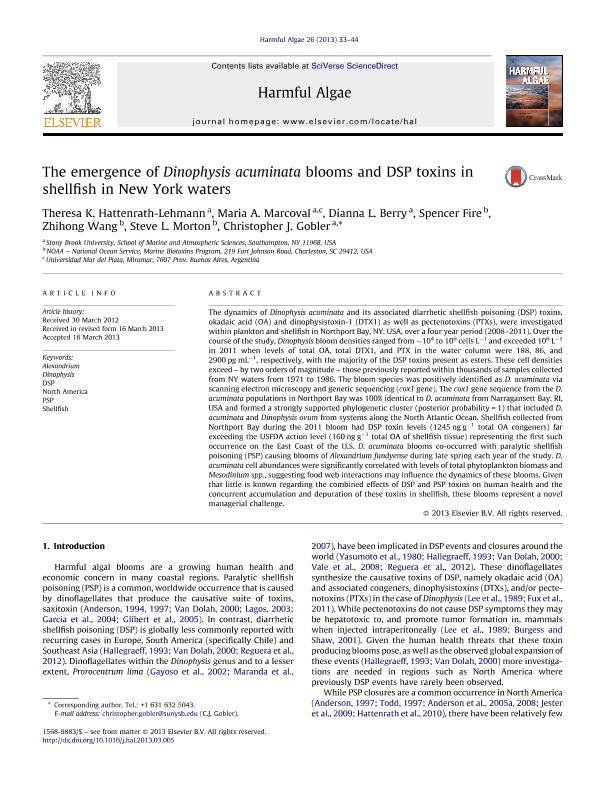Artículo
The emergence of Dinophysis acuminata blooms and DSP toxins in shellfish in New York waters
Hattenrath Lehmann, Theresa K.; Marcoval, Maria Alejandra ; Berry, Dianna L.; Fire, Spencer; Wang, Zhihong; Morton, Steve L,; Gobler, Christopher J.
; Berry, Dianna L.; Fire, Spencer; Wang, Zhihong; Morton, Steve L,; Gobler, Christopher J.
 ; Berry, Dianna L.; Fire, Spencer; Wang, Zhihong; Morton, Steve L,; Gobler, Christopher J.
; Berry, Dianna L.; Fire, Spencer; Wang, Zhihong; Morton, Steve L,; Gobler, Christopher J.
Fecha de publicación:
03/2013
Editorial:
Elsevier Science
Revista:
Harmful Algae
ISSN:
1568-9883
Idioma:
Inglés
Tipo de recurso:
Artículo publicado
Clasificación temática:
Resumen
The dynamics of Dinophysis acuminata and its associated diarrhetic shellfish poisoning (DSP) toxins, okadaic acid (OA) and dinophysistoxin-1 (DTX1) as well as pectenotoxins (PTXs), were investigated within plankton and shellfish in Northport Bay, NY, USA, over a four year period (2008–2011). Over the course of the study, Dinophysis bloom densities ranged from 104 to 106 cells L1 and exceeded 106 L1 in 2011 when levels of total OA, total DTX1, and PTX in the water column were 188, 86, and 2900 pg mL1 , respectively, with the majority of the DSP toxins present as esters. These cell densities exceed – by two orders of magnitude – those previously reported within thousands of samples collected from NY waters from 1971 to 1986. The bloom species was positively identified as D. acuminata via scanning electron microscopy and genetic sequencing (cox1 gene). The cox1 gene sequence from the D. acuminata populations in Northport Bay was 100% identical to D. acuminata from Narragansett Bay, RI, USA and formed a strongly supported phylogenetic cluster (posterior probability = 1) that included D. acuminata and Dinophysis ovum from systems along the North Atlantic Ocean. Shellfish collected from Northport Bay during the 2011 bloom had DSP toxin levels (1245 ng g1 total OA congeners) far exceeding the USFDA action level (160 ng g1 total OA of shellfish tissue) representing the first such occurrence on the East Coast of the U.S. D. acuminata blooms co-occurred with paralytic shellfish poisoning (PSP) causing blooms of Alexandrium fundyense during late spring each year of the study. D. acuminata cell abundances were significantly correlated with levels of total phytoplankton biomass and Mesodinium spp., suggesting food web interactions may influence the dynamics of these blooms. Given that little is known regarding the combined effects of DSP and PSP toxins on human health and the concurrent accumulation and depuration of these toxins in shellfish, these blooms represent a novel managerial challenge.
Palabras clave:
Alexandrium
,
Dinophysis
,
Dsp
,
North America
,
Psp
,
Shellfish
Archivos asociados
Licencia
Identificadores
Colecciones
Articulos(CCT - MAR DEL PLATA)
Articulos de CTRO.CIENTIFICO TECNOL.CONICET - MAR DEL PLATA
Articulos de CTRO.CIENTIFICO TECNOL.CONICET - MAR DEL PLATA
Citación
Hattenrath Lehmann, Theresa K.; Marcoval, Maria Alejandra; Berry, Dianna L.; Fire, Spencer; Wang, Zhihong; et al.; The emergence of Dinophysis acuminata blooms and DSP toxins in shellfish in New York waters; Elsevier Science; Harmful Algae; 26; 3-2013; 33-44
Compartir
Altmétricas



